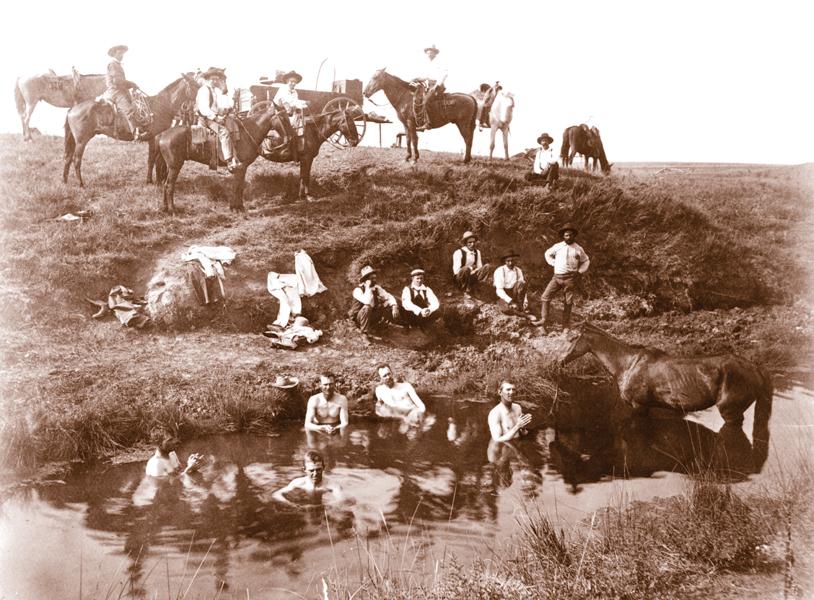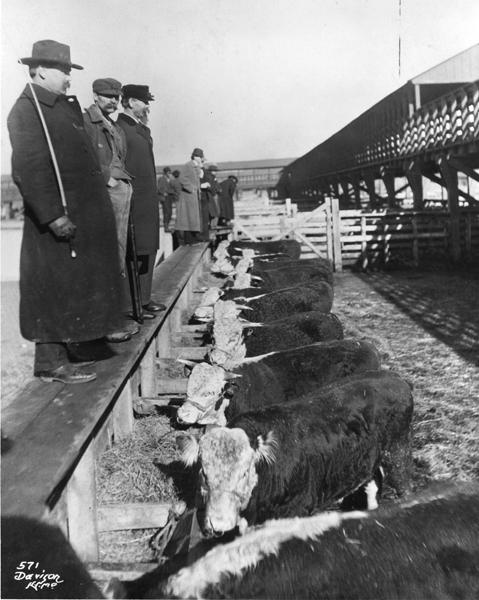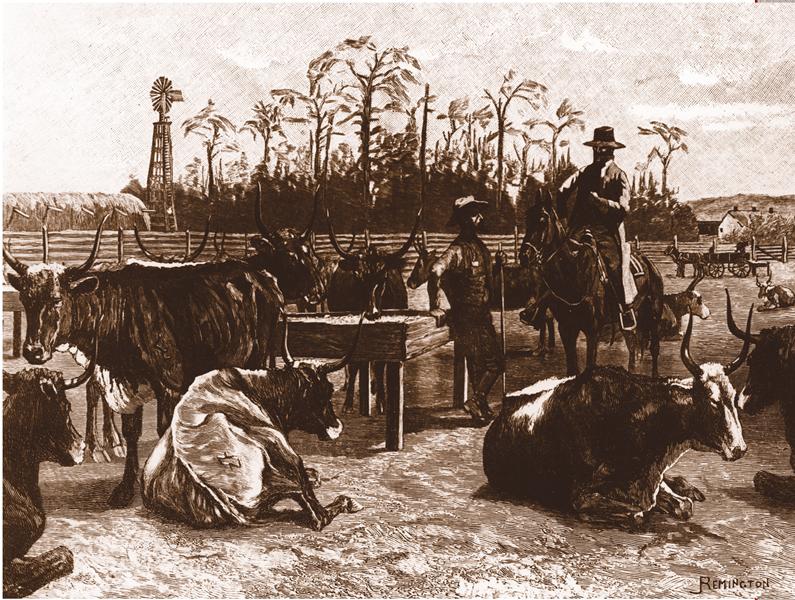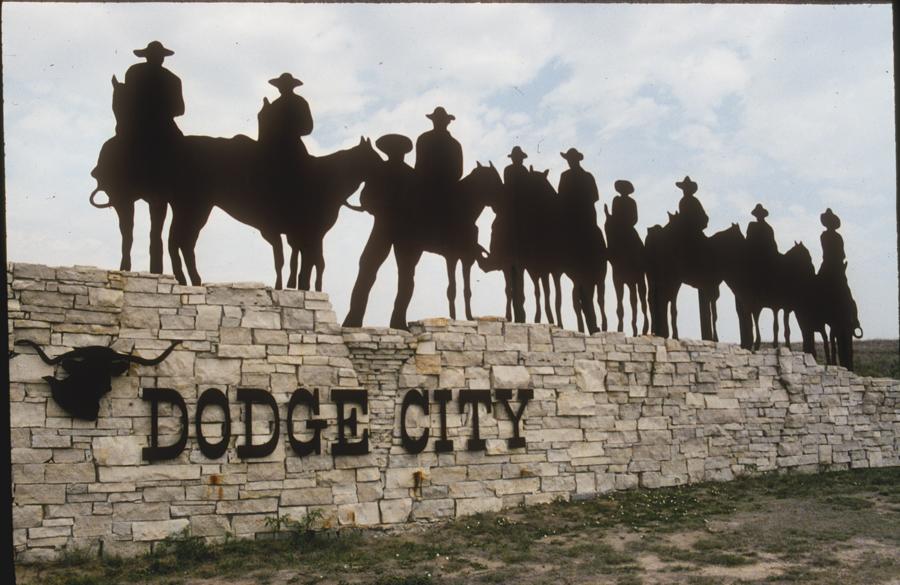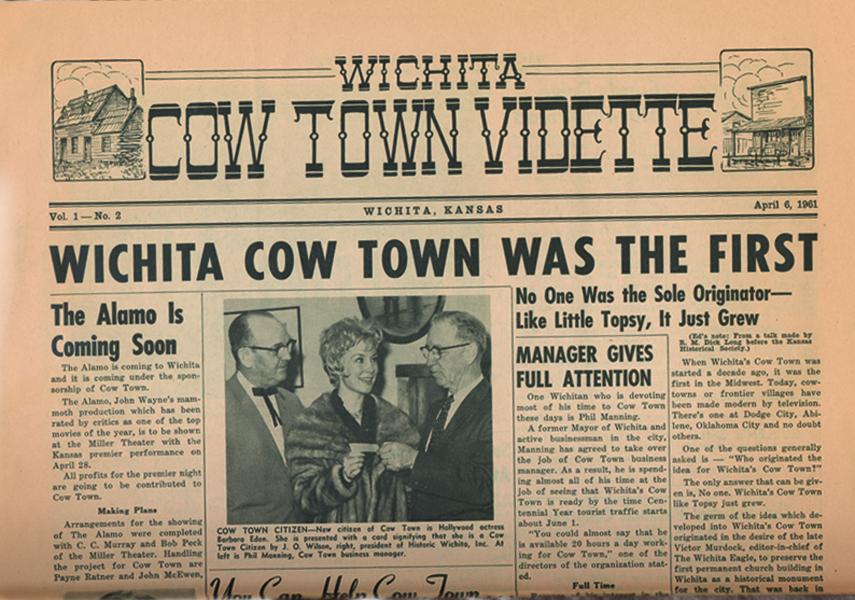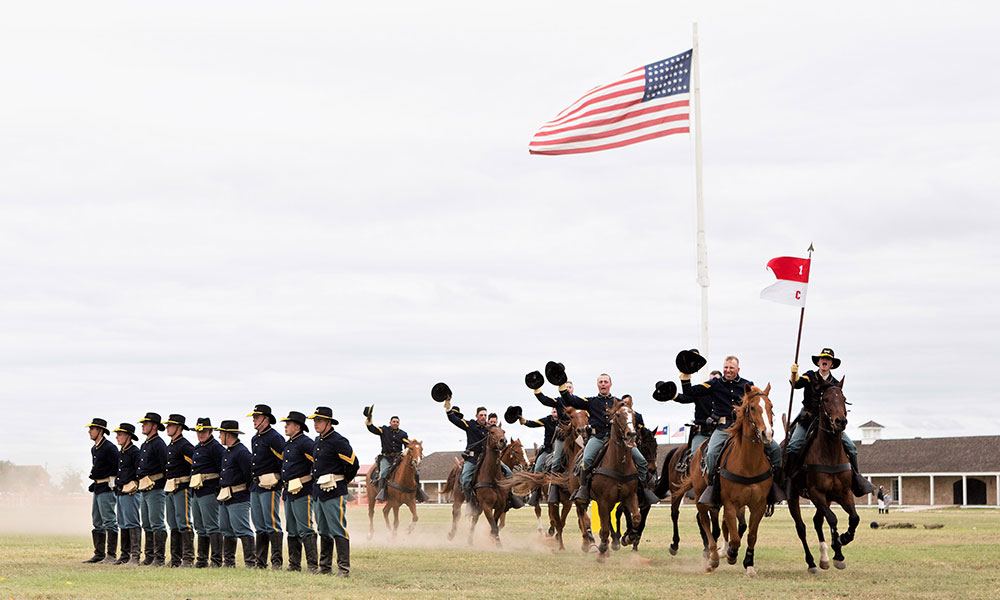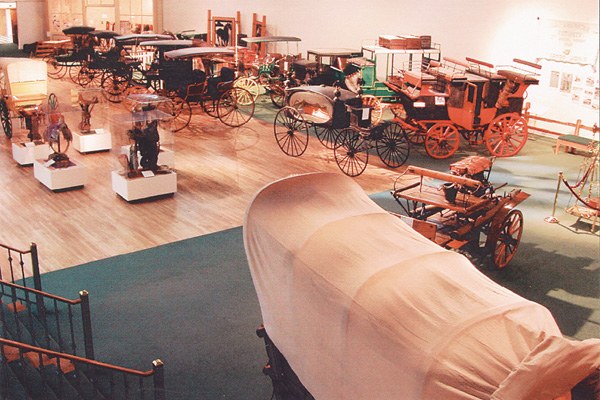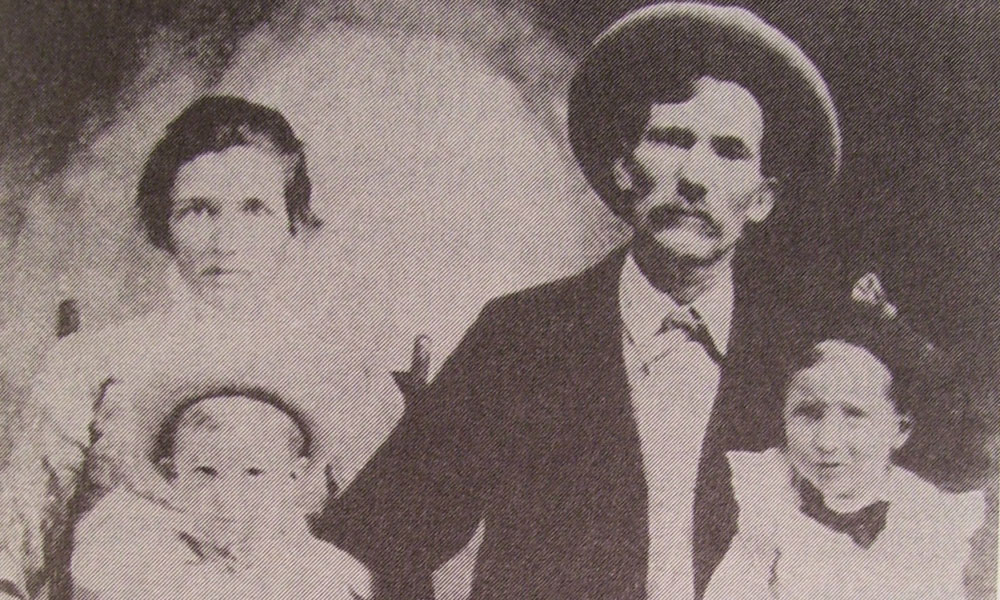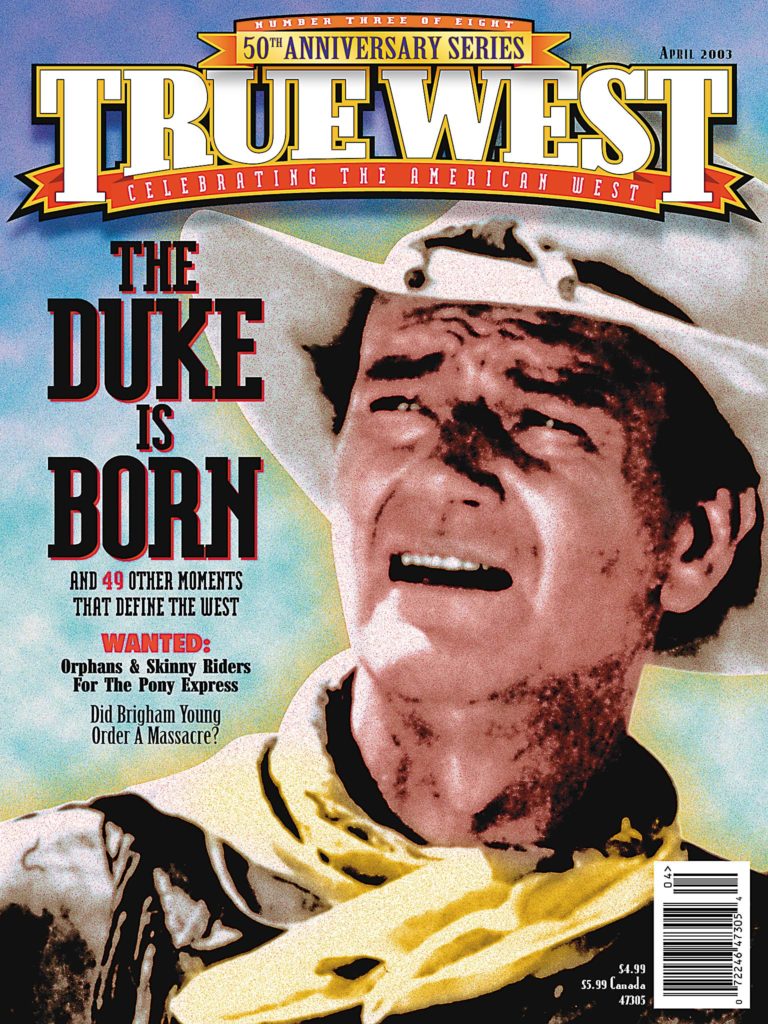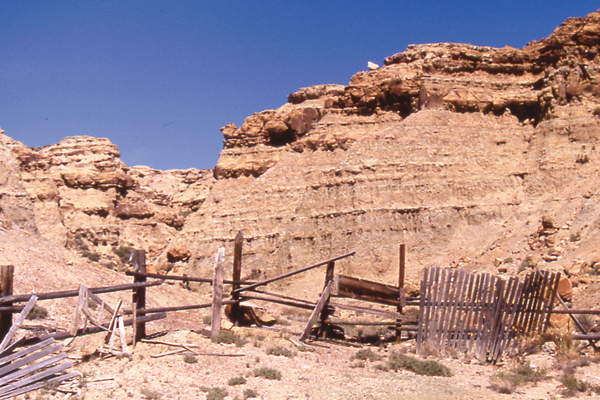 The cowboys, longhorns and chuck wagon on the bluff two miles south of Caldwell, Kansas, aren’t making any progress.
The cowboys, longhorns and chuck wagon on the bluff two miles south of Caldwell, Kansas, aren’t making any progress.
Since 1995, this trail herd has been pointed north at the same spot just east of the railroad tracks.
The marker commemorating the life-size silhouette sculpture Ghost Riders of the Chisholm Trail notes: “So life-like is the scene, observers are certain they have noticed both dust and sounds coming from the bluff area.”
Uh-huh. And that waddie with the lariat looks just like Montgomery Clift in Red River.
Still, you can’t fault the six burgs comprising the Kansas Cattle Towns Coalition for promoting their heritage (www.kansascattletowns.com). Ghost Riders isn’t that cheesy (don’t worry, we’ll get to Dodge City’s Boot Hill Museum for all you cheeseheads), and many of these towns are seeing history come full circle.
Cow town entrepreneurs didn’t just wait around twiddling their thumbs. They went out and drummed up business, each promoting his hamlet as the best market for Texas trail herds. In some ways, that’s what today’s historical cow towns are doing, trying to bring in tourists instead of Texas waddies. In fact, that’s the reason the Kansas Cattle Towns Coalition was formed.
I leave the Ghost Riders without seeing a speck of dust or hearing a steer bawl and drive up U.S. 81 to begin this trail drive.
Caldwell
“The Border Queen” is sleeping late this Sunday, but that was rarely the case in the late 1800s. Between 1879 and 1885 this cattle town went through 16 marshals, including one Henry Brown, who tried to supplement his income by robbing the Medicine Lodge Bank and was gunned down by grouchy vigilantes.
Seventeen markers detail the history of many Caldwell buildings, including the Stock Exchange Bank and Grand Opera House, and events such as the Last Land Rush and Talbot Gang Shoot-out. You can pick up a free map and tour guide from the Visitors Plaza at Main and First.
You can also pick up some grub at the tin-ceiling Last Chance Bar & Grill (another historical building, though no one called it a grill, or a bar for that matter, during Caldwell’s wild cowboy years). And if you make an appointment, you can talk to ghosts (okay, re-enactors) in the Talking Tombstones program at the Caldwell Cemetery.
Caldwell is also home to two museums (again, by appointment): The Cherokee Strip Center (City Park at West Central) and Border Queen Museum (1 N. Main).
With 1,351 people in this city west of Interstate 35, Caldwell knows the value of promoting cowboy culture. In addition to tours and such, the Chisholm Trail Festival is held in April. My hat’s off to this cow town as I head to a more cosmopolitan city that still salutes its beef and beans heritage.
Wichita
The town’s tamer since Wyatt Earp, Bat Masterson and others of their ilk took their leave. Today, Wichita is a big city—biggest in Kansas, in fact, population 318,600—and there is crime, along with traffic jams. But several sites make the urban headaches worthwhile.
Foremost is the 17-acre Old Cowtown Museum (1871 Sim Park Drive), one of the West’s best open-air, living-history museums. Thirty-five exhibit areas, including the town’s first jail, illustrate Wichita’s growth from cow town to farming center between 1865-80.
Other interesting stops on the museum circuit include the Wichita-Sedgwick County Historical Museum (204 S. Main), offering a Chisholm Trail pictorial, and the Indian Center Museum (650 N. Seneca). You could spend a day or two touring Wichita’s museums (Great Plains Transportation Museum, Kansas African American Museum, Kansas Aviation Museum, Kansas Firefighters Museum, Wichita Art Museum, Frank Lloyd Wright Allen-Lambe House Museum & Study Center. . . .)
Sheplers Western Wear calls Wichita its headquarters and has a store at 6501 W. Kellogg. More good shopping is to be had in the Old Town District, east of downtown. This restored, 10-block, warehouse district has more than 200 shops, restaurants, nightclubs and dinner theaters.
Hang your hat in Wichita for a steak and comfortable bed, but don’t hog your hotel’s continental breakfast the next morning. Tell your belly to wait ’til Newton.
Newton
Talk about a turnaround. This peaceful Mennonite community off I-135 was once known as “Bloody Newton.” Of the six coalition towns, Newton is the least cowboy. North Newton’s Kauffman Museum (27th and North Main) emphasizes the Mennonites, but swales created by more than a million longhorns are allegedly evident at Trails Park.
What makes Newton special is the food. Stop in at C.J.’s Pancake House, the Breadbasket, the Coffee Pot or Curtis C’s Diner for a taste of Kansas breakfast cuisine, then point your car north and drive to the most famous of cow towns.
Abilene
At Salina, I turn east on I-70 and head for Abilene, where Joseph McCoy’s railroad venture started this Kansas cow town craziness. Tom Smith and Wild Bill Hickok used their fists and pistols, respectively, to help bring a semblance of law and order to this wild and woolly cow town.
Abilene promotes—and rightfully so—its hometown hero, Dwight D. Eisenhower, but the cowboys get their due at the Dickinson County Historical Museum (412 S. Campbell).
On the other hand, Old Abilene Town & Museum (S.E. Sixth at Buckeye) claims to put on gunfights and stagecoach rides, but every time I’ve driven by, it looks abandoned and weathered. On the grounds of the reconstructed cattle town is Fort Chisholm (not reminiscent of the Old Cowtown or Boot Hill Museums). I pass the Fort Chisholm gift shop—the biggest in Kansas, a sign proclaims—but it looks as dead as Abilene did after the trail drovers moved West.
You won’t leave Abilene disappointed however, if you hit the next two stops. The American Indian Art Center (206 S. Buckeye) is the state’s only Native American art gallery, and the Kirby House Restaurant (205 N.E. Third) is a restored 1885 mansion of banker Thomas Kirby.
Ellsworth
Of all the Kansas cow towns, this little burg (where State Highways 14 and 156 converge) is the least commercial and the most authentic. It’s not exactly hip, but it’s definitely a special treat.
The main reason sits at 119 N. Douglas. Drovers Mercantile sells replica 1870s cowboy duds and cookware, and Jim Gray (who founded the store with Linda Kohls) is a walking history book who can point out the cow town highlights, like the exact spot of a bloody 1873 shoot-out involving Ben Thompson and his brother. Signs also provide a walking tour of Ellsworth’s heritage.
On top of that, Gray is the brainchild behind the C.O.W.B.O.Y. (Cockeyed Old West Band of Yahoos) Society and its official publication, Kansas Cowboy. He’ll sign you up for $18.67.
(P.S. If your stomach’s growling after Gray talks your ear off, don’t fret. Step across the street to Paden’s Place for a filling chicken-fried steak.)
Next door to the Drovers is Johnny Bingo’s Hats, but he’s not in when I drop by, so I head off to the Hodgden House Museum. An 1880s livery stable, a 1912 one-room school and an 1880s church are housed in the museum complex, in addition to the stone home a gent named Perry Hodgden had built in 1878 after fires swept through Ellsworth in the mid-1870s.
Accommodations in Ellsworth are few and far between, but the Ira E. Lloyd House Bed & Breakfast, a restored 1895 home, comes highly recommended, while the Best Western Garden Prairie Inn is perfect for families.
Now it’s southwest on State Highway 156 to U.S. 56 and on to, at last, the wickedest cow town.
Dodge City
Don’t worry, the “Cowboy Capital of the World” hasn’t forgotten its roots. A scenic turnout east of town doesn’t overlook Fort Dodge or the rolling Kansas prairie. Nope, instead you have a fine view of a sprawling feed lot.
Dodge City attracts more than unfortunate cattle. Tourists—those who believe Matt Dillon was a real marshal (there is a Gunsmoke Street after all, and Miss Kitties are everywhere), and those more familiar with the real West (Wyatt Earp Boulevard’s a main drag)—still make it here.
History buffs can find a wealth of information at the Kansas Heritage Center (1000 Second Ave.) and the Boot Hill Museum library. For theater lovers, Wyatt Earp Boulevard isn’t exactly Broadway, but the old depot and Harvey House have been restored into a performing arts center.
Take a narrated trolley ride for an informative look at Dodge City, then stroll over to El Capitan, a bronze statue by Jasper D’Ambrosi that celebrates the trail drives.
Most people think of these cow towns as hardscrabble, but the Home of Stone (112 E. Vine) shows that because of the Santa Fe Trail and the railroad, the citizens weren’t so far from civilization. Built by bootmaker John Mueller in 1881, this three-story limestone house contains several original furnishings and a splendid collection of Ford County history.
And, of course, there’s the Boot Hill Museum (Front and Fifth), located on the original site of Boot Hill Cemetery. We promised something for the cheeseheads when we started this road trip, and the museum acts, such as the Long Branch Variety Show, probably haven’t changed a line in 50-plus years.
Only, don’t write off the museum’s 1876 reconstruction of Front Street buildings as total corn. A lot of the buildings’ furnishings are the real deal. Wander about the museum, check out the displays and go ahead, smile at the corny jokes.
Dodge City was the last great cow town in a relatively brief period (1867-85). There were other cattle towns, of course, but most have forgotten their part in history, or they simply ignore it. The “Buffalo Capital of the World,” “Wickedest Little City in America” and “Beautiful Bibulous Babylon of the Frontier” not only remembers its place in the settling of the Western frontier, Dodge City celebrates it.
I can’t think of a better end of a trail for this cowboy.
Johnny D. Boggs seconds this advice from well-traveled friend Jon Chandler: “Don’t order Mexican food in Kansas.”
Photo Gallery
– True West Archives –
– Painting by Frederic Remington –
– Courtesy Johnny D. Boggs –
– True West Archives –


